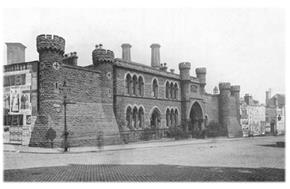
In 2018 Dr Rosalind Crone of The Open University launched the 19th Century Prisons database at www.prisonhistory.org which has recently been updated and extended.
Alongside the 19th Century Prisons database (www.prisonhistory.org/19th-century-prisons/), which provides a searchable list of 847 prisons and their archives, Rosalind Crone has developed Your Local Lock-Up; a public engagement project which aims to locate any structures used for temporary imprisonment or restraint. These lock-ups might have confined the accused until they appeared before a local magistrate, when being moved between penal institutions, or when undergoing trial. Some lock-ups, like stocks, could also have been used to punish those ‘behaving badly’ in the local community.
Lock-ups have been almost entirely overlooked by penal historians, but they are essential for understanding criminal justice at the local level, and the use and experience of imprisonment in British history. Your Local Lock-Up at www.prisonhistory.org/local-lock-up/ is building a national database of surviving or demolished lock-ups and other places of local confinement. This will allow us to explore various aspects of lock-ups’ use, character and design, and enable us to complete the next stage in the recovery of the penal landscape of historic Britain.
To do this, we now need the help of local historians! There are around 650 lock-ups in the database at www.prisonhistory.org/local-lock-up/, but currently only 7 for Nottinghamshire. This is far from exhaustive, and we anticipate that there are countless others we know nothing about. We are therefore calling upon local historians and members of the public to help us recover more lock-ups, and would be very grateful if you could tell us about any in your area. The project is compiling data on any place or structure used for temporary confinement between the 16th and early 20th centuries; including purpose built lock-ups, police stations, cells in town halls, courthouses, workhouses, stocks and even rooms in pubs used to detain prisoners.
You can easily contribute information on a new lock-up directly into the database through an online form at www.prisonhistory.org/locallock-up/submit-lock-up. Or if there are more details and photographs of somewhere already listed in the database please make any additions or corrections via the ‘Anything to Add’ button on each lock-up entry. We are also inviting anyone interested in lock-ups and penal history more generally to join our project team to help with research and the development of the database at www.prisonhistory.org/local-lock-up/become-a-contributor/
Your Local Lock-Up is interested in collecting many different types of evidence on lock-ups, and especially welcomes historic and present-day descriptions of structures or their uses, and pictures. It need not be written evidence, either. We are equally keen to hear anecdotes about incidents involving the lock-up, the prisoners held there and the location of any that are now lost.
We are also collecting ‘stories’ of lock-ups or prisons for our new features page, some of which can already be seen at www.prisonhistory.org/category/stories/.
To increase Your Local Lock-Up’s usefulness to local history societies and communities, every lock-up entry in the database includes a ‘print’ button, which generates a ready-made pamphlet containing information and an image that can be displayed or distributed. Please do let us know if this facility is of use and whether there are any additional features that you would find valuable on the site. We need your feedback to develop this resource further!
Finally, why not connect with Prison History UK on social media? You can follow us on Twitter (https://twitter.com/prisonhistoryuk), ‘like’ our Facebook page (www.facebook.com/Prison-History-UK-2390455521218014 ); and share material with us on Instagram (www.instagram.com/prisonhistoryuk). You can also subscribe directly to our mailing list at www.prisonhistory.org to receive the latest project news and updates.






